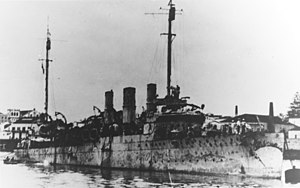USS Conner (DD-72)

USS Conner
|
|
| History | |
|---|---|
|
|
|
| Name: | USS Conner |
| Namesake: | Commodore David Conner |
| Builder: | William Cramp & Sons Ship and Engine Building Company Philadelphia, Pennsylvania |
| Launched: | 21 August 1917 |
| Commissioned: | 12 January 1918 |
| Decommissioned: | 23 October 1940 |
| Identification: | DD-72 |
| Fate: | Transferred to Britain on 23 October 1940 |
|
|
|
| Name: | HMS Leeds |
| Acquired: | 23 October 1940 |
| Fate: | Placed in reserve at Grangemouth in the Firth of Forth in April 1945. |
| General characteristics | |
| Class and type: | Caldwell-class destroyer |
| Displacement: |
|
| Length: | 315 ft 6 in (96.16 m) |
| Beam: | 31 ft 4 in (9.55 m) |
| Draft: | 8 ft 1 in (2.46 m) |
| Propulsion: |
|
| Speed: | 30 knots (56 km/h; 35 mph) |
| Complement: | 100 officers and enlisted |
| Armament: |
|
USS Conner (DD-72), a Caldwell-class destroyer, served in the United States Navy, and later in the Royal Navy as HMS Leeds.
The first US Navy ship named for Commodore David Conner (1792–1856), Conner was launched 21 August 1917 by William Cramp & Sons Ship and Engine Building Company, Philadelphia, sponsored by Miss E. Diederich, and commissioned 12 January 1918, Commander A. G. Howe in command.
Conner put to sea from New York 12 May 1918 to escort a convoy to the Azores and Brest, France. From Brest, she operated with U.S. Naval Forces, France, escorting convoys inbound to British and French ports, and outbound for Bermuda. Frequently sent to aid ships which had reported sighting submarines, she rescued survivors from the sea twice in July 1918. At the end of the war, she had duty on regular mail and passenger runs between Brest and Plymouth, England, and on 8 May 1919, she put out from Plymouth escorting the ships carrying President Woodrow Wilson and Secretary of the Navy Josephus Daniels to Brest for the Peace Conference.
Returning to the United States, Conner joined in fleet maneuvers in Narragansett Bay in the summer of 1919, and entered Philadelphia Navy Yard 4 October. Later she lay at Norfolk, Virginia in reserve until May 1921, when she participated in large-scale fleet exercises with a reduced complement. She remained at Newport, Rhode Island, for operations with submarines. Between 13 October 1921 and 29 March 1922, she lay at Charleston, South Carolina, returning then to Philadelphia, where she was decommissioned 21 June 1922.
...
Wikipedia
